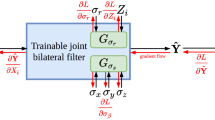Abstract
Low-dose computed tomography (CT) denoising algorithms aim to enable reduced patient dose in routine CT acquisitions while maintaining high image quality. Recently, deep learning (DL)-based methods were introduced, outperforming conventional denoising algorithms on this task due to their high model capacity. However, for the transition of DL-based denoising to clinical practice, these data-driven approaches must generalize robustly beyond the seen training data. We, therefore, propose a hybrid denoising approach consisting of a set of trainable joint bilateral filters (JBFs) combined with a convolutional DL-based denoising network to predict the guidance image. Our proposed denoising pipeline combines the high model capacity enabled by DL-based feature extraction with the reliability of the conventional JBF. The pipeline’s ability to generalize is demonstrated by training on abdomen CT scans without metal implants and testing on abdomen scans with metal implants as well as on head CT data. When embedding RED-CNN/QAE, two well-established DL-based denoisers in our pipeline, the denoising performance is improved by 10%/82% (RMSE) and 3%/81% (PSNR) in regions containing metal and by 6%/78% (RMSE) and 2%/4% (PSNR) on head CT data, compared to the respective vanilla model. Concluding, the proposed trainable JBFs limit the error bound of deep neural networks to facilitate the applicability of DL-based denoisers in low-dose CT pipelines.We made our trainable bilateral filter layer package (PyTorch, GPU accelerated) publicly available [1, 2].
Chapter PDF
Similar content being viewed by others
References
Wagner F, Thies M, Denzinger F, Gu M, Patwari M, Ploner S et al. Trainable joint bilateral filters for enhanced prediction stability in low-dose CT. Sci Rep. 2022;12(1):1–9.
Wagner F, Thies M, Denzinger F, Gu M, Patwari M, Ploner S et al. Trainable joint bilateral filter layer (PyTorch). https://github.com/faebstn96/trainable- jointbilateral-filter-source. Accessed: 9 Dec 2022.
Author information
Authors and Affiliations
Corresponding author
Editor information
Editors and Affiliations
Rights and permissions
Copyright information
© 2023 Der/die Autor(en), exklusiv lizenziert an Springer Fachmedien Wiesbaden GmbH, ein Teil von Springer Nature
About this paper
Cite this paper
Wagner, F. et al. (2023). Abstract: Trainable Joint Bilateral Filters for Enhanced Prediction Stability in Low-dose CT. In: Deserno, T.M., Handels, H., Maier, A., Maier-Hein, K., Palm, C., Tolxdorff, T. (eds) Bildverarbeitung für die Medizin 2023. BVM 2023. Informatik aktuell. Springer Vieweg, Wiesbaden. https://doi.org/10.1007/978-3-658-41657-7_16
Download citation
DOI: https://doi.org/10.1007/978-3-658-41657-7_16
Published:
Publisher Name: Springer Vieweg, Wiesbaden
Print ISBN: 978-3-658-41656-0
Online ISBN: 978-3-658-41657-7
eBook Packages: Computer Science and Engineering (German Language)




